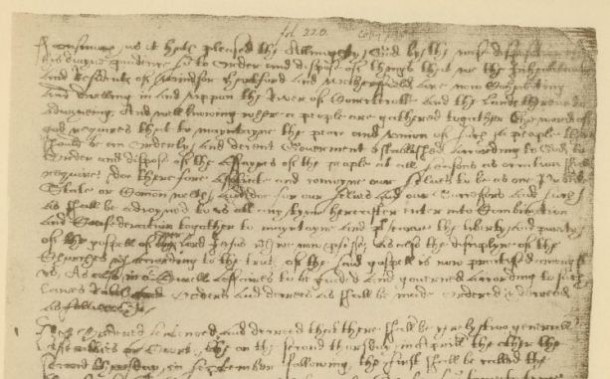1.) What concepts are included in the Mayflower Compact?
The three topics discussed in the Mayflower Compact were what had happened, why it had happened, and what these settlers intend to happen. In this case that was landing in Virginia, because they felt compelled by god and their king to advance their faith and kingdom, for the purpose of settling a colony there.
2.) How does the Mayflower Compact reflect and attachment to both the "Old" and "New" worlds?
You can see the connection to the old world in the colonist's motives. Their reasoning for embarking on this journey is to honor King James of Great Britain, an old world king, and to further the spread of Christianity, an old world religion. You can also see this when they signed it "loyal subjects", showing reverence to their old flag. However, their attachment to the new world comes in the form of their new "civil body politick", in which they will govern themselves.
3.) How did the fundamental orders of Connecticut differ from the Mayflower Compact?
The main difference between the two is that the Mayflower Compact is significantly more general than the fundamental orders of Connecticut. The Mayflower Compact serves more to inform people of the colonist's motives and reasons for settling their colony, whereas the fundamental orders of Connecticut serve to direct their government and establish laws.
4.) What prompted the colonists of Connecticut to take this approach to government, i.e.: use of a written constitution?
Given the time of absolute monarchies in Europe it is reasonable to believe that the colonists of Connecticut were attempting to avoid this totalitarian fate. In Europe governments without written constitutions often saw abuses of power and tyrannical rulers. However, in new governments of the time there were written constitutions, that limited the power of individuals, and allowed democratic elections to take place, that had allowed citizens to live relatively freely.
5.) In what significant way(s) does the Fundamental Orders reflect a fear of and safeguard against the usurping of power by one person or a chosen few?
The colonist's fear of one person having too much power is reflected by their constant checks and balances within the Orders. One example of this is the Great Court, consisting of executive, judiciary, and legislative powers, rather than solely functioning as a court. In addition to this every individual who did gain power had to be chosen by others for this power, and had limits to the length in which they could hold this power. This came in the form of term limits and democratic elections.
Mayflower Compact: Fundamental Orders of Connecticut:


Declaration of Independence (Synthesis):

The three topics discussed in the Mayflower Compact were what had happened, why it had happened, and what these settlers intend to happen. In this case that was landing in Virginia, because they felt compelled by god and their king to advance their faith and kingdom, for the purpose of settling a colony there.
2.) How does the Mayflower Compact reflect and attachment to both the "Old" and "New" worlds?
You can see the connection to the old world in the colonist's motives. Their reasoning for embarking on this journey is to honor King James of Great Britain, an old world king, and to further the spread of Christianity, an old world religion. You can also see this when they signed it "loyal subjects", showing reverence to their old flag. However, their attachment to the new world comes in the form of their new "civil body politick", in which they will govern themselves.
3.) How did the fundamental orders of Connecticut differ from the Mayflower Compact?
The main difference between the two is that the Mayflower Compact is significantly more general than the fundamental orders of Connecticut. The Mayflower Compact serves more to inform people of the colonist's motives and reasons for settling their colony, whereas the fundamental orders of Connecticut serve to direct their government and establish laws.
4.) What prompted the colonists of Connecticut to take this approach to government, i.e.: use of a written constitution?
Given the time of absolute monarchies in Europe it is reasonable to believe that the colonists of Connecticut were attempting to avoid this totalitarian fate. In Europe governments without written constitutions often saw abuses of power and tyrannical rulers. However, in new governments of the time there were written constitutions, that limited the power of individuals, and allowed democratic elections to take place, that had allowed citizens to live relatively freely.
5.) In what significant way(s) does the Fundamental Orders reflect a fear of and safeguard against the usurping of power by one person or a chosen few?
The colonist's fear of one person having too much power is reflected by their constant checks and balances within the Orders. One example of this is the Great Court, consisting of executive, judiciary, and legislative powers, rather than solely functioning as a court. In addition to this every individual who did gain power had to be chosen by others for this power, and had limits to the length in which they could hold this power. This came in the form of term limits and democratic elections.
Mayflower Compact: Fundamental Orders of Connecticut:


Declaration of Independence (Synthesis):

Comments
Post a Comment